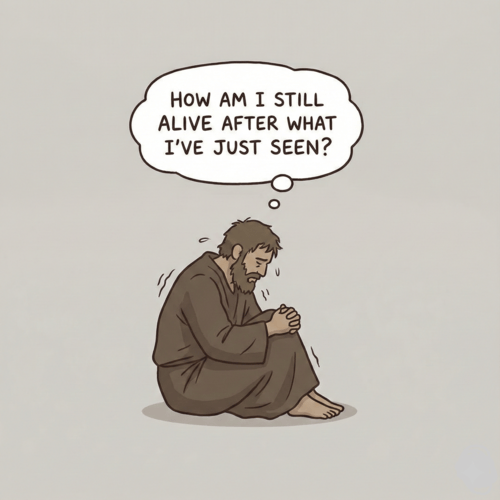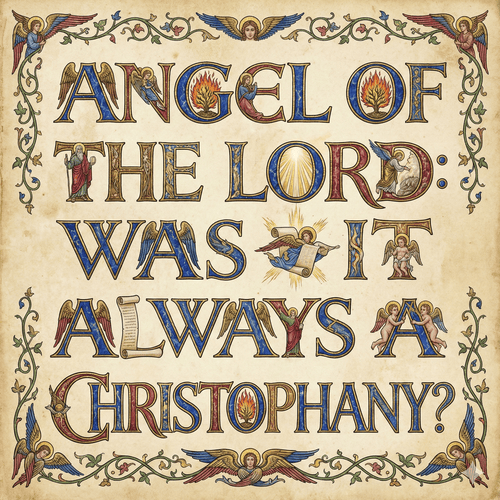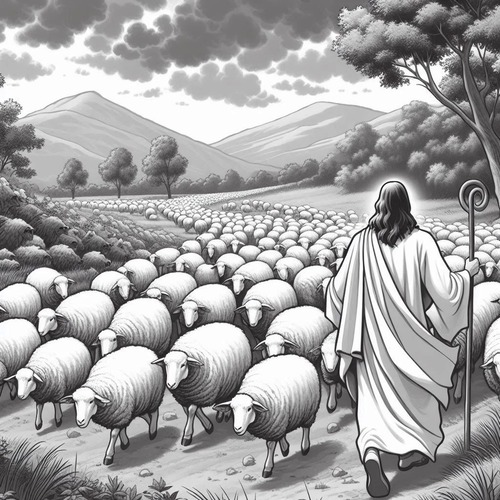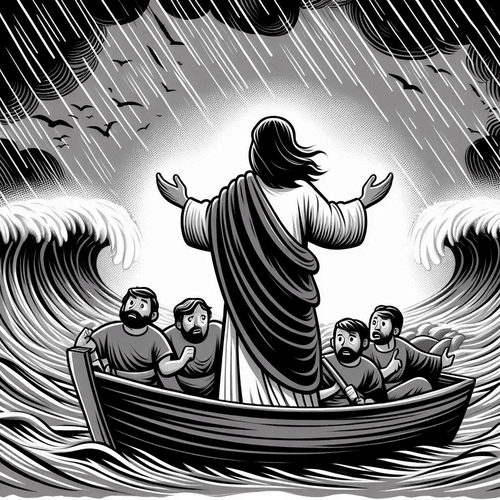Old Testament Theophanies: What Purposes Did They Serve?
Throughout the Old Testament, we encounter remarkable moments when God manifests Himself in visible, often tangible forms to His people. These divine appearances, known as theophanies, represent critical junctures in redemptive history. But what exactly were these appearances, and why did God choose to reveal Himself in such direct, physical ways before the coming of Christ?
WHAT IS A THEOPHANY?
A theophany is a visible manifestation of God in which He takes temporary physical form to interact with His creation. The word comes from two Greek terms: theos (God) and phainein (to appear). In these extraordinary encounters, the invisible God makes Himself visible to human eyes—not in His full divine essence, which no man can see and live (Exodus 33:20), but in accommodated forms that human beings could comprehend.
KEY THEOPHANIES IN SCRIPTURE
The Old Testament records numerous theophanies, each serving specific purposes in God’s unfolding plan:
- The LORD walking in Eden (Genesis 3:8): God appears in the garden seeking Adam and Eve after their sin, demonstrating both His desire for fellowship and His role as righteous judge.
- Abraham’s visitors at Mamre (Genesis 18): The LORD appears with two angels, sharing a meal and covenant promises with Abraham, demonstrating divine condescension and covenant confirmation.
- Jacob wrestling with God (Genesis 32:22-32): Jacob physically wrestles with a divine figure, receiving both a blessing and a permanent reminder of the encounter through his injured hip.
- Moses and the burning bush (Exodus 3): God appears in flame that doesn’t consume the bush, revealing His name and commissioning Moses to lead Israel from bondage.
- The pillar of cloud and fire (Exodus 13:21-22): God guides Israel as a visible, constant presence throughout their wilderness wanderings.
- God’s appearance at Sinai (Exodus 19-20): The LORD descends on the mountain with thunder, lightning, and fire to establish His covenant with Israel.
- Isaiah’s vision in the temple (Isaiah 6): The prophet sees the Lord “high and lifted up,” revealing divine holiness and commissioning Isaiah for prophetic ministry.
- The fourth man in the fiery furnace (Daniel 3:24-25): King Nebuchadnezzar observes a divine figure—“like a son of the gods”—protecting Shadrach, Meshach, and Abednego in the flames, demonstrating God’s supernatural protection of His faithful servants.
THE REFORMED UNDERSTANDING OF THEOPHANIES
In Reformed theology, these appearances are often understood as Christophanies—pre-incarnate appearances of the Second Person of the Trinity, the Son of God who would later take permanent human form as Jesus Christ. This understanding is supported by several biblical indicators:
- John 1:18 states “No one has ever seen God; the only God, who is at the Father’s side, he has made him known.”
- Jesus Himself claimed, “Whoever has seen me has seen the Father” (John 14:9).
- The New Testament identifies Christ as the creator and sustainer of all things (Colossians 1:15-17), the perfect image of the invisible God.
Theophanies represent God’s accommodation to human limitations. Unable to comprehend the fullness of divine glory, human beings needed God to “step down” and reveal Himself in forms they could grasp. Each theophany thus served as a gracious bridge between divine transcendence and human finitude.
PURPOSES OF THEOPHANIES IN SCRIPTURE
Old Testament theophanies served several vital purposes in God’s redemptive plan:
To Reveal God’s Character and Attributes: Theophanies provided vivid demonstrations of who God is. At Sinai, Israel witnessed God’s holiness and power through thunder, lightning, and fire. In the burning bush, Moses encountered God’s self-existence and eternality (“I AM WHO I AM”). Each appearance highlighted different divine attributes, giving Israel a fuller understanding of their covenant Lord.
To Confirm Covenant Promises: When God appeared to Abraham at Mamre, He reaffirmed His covenant promises concerning Isaac’s birth and Abraham’s descendants. Theophanies often marked pivotal moments of covenant establishment or renewal, providing tangible assurance of God’s commitment.
To Authenticate Divine Messengers: Moses’ encounter at the burning bush authenticated his call to lead Israel. Isaiah’s vision in the temple confirmed his prophetic commission. Theophanies validated human messengers as true representatives of divine authority.
To Prepare for the Incarnation: These temporary divine appearances foreshadowed the ultimate theophany—God taking permanent human form in Jesus Christ. They prepared God’s people to understand the concept of God appearing in visible form, creating theological categories that would help them recognize Jesus as “God with us.”
To Demonstrate God’s Nearness: The pillar of cloud and fire showed Israel that God was not distant but present among them. The fourth man in the fiery furnace revealed God’s presence with His people even in their most severe trials. Theophanies countered the notion of God as remote or uninvolved in human affairs.
To Visually Teach Vital Truths: Through these visible appearances, God taught truths that might otherwise remain abstract. The burning bush illustrated how God could be intimately present with creation without being consumed by it. Jacob’s wrestling match demonstrated how covenant relationship involves both struggle and blessing.
WHY HAVE THEOPHANIES CEASED IN THE NEW TESTAMENT ERA
Theophanies largely disappeared after Christ’s coming for profound theological reasons:
- Christ is the ultimate theophany: Colossians 2:9 declares that “in him the whole fullness of deity dwells bodily.” Jesus is not merely a temporary appearance of God but God Himself permanently united with human nature. Where temporary theophanies pointed forward, Christ fulfils.
- “Whoever has seen me has seen the Father”: Jesus’ statement in John 14:9 indicates that He perfectly reveals God in human form. No further theophanies are needed when God has revealed Himself definitively in Christ.
- The sending of the Holy Spirit: After Christ’s ascension, God manifests His presence through the indwelling Spirit rather than visible appearances. The Spirit’s presence fulfils Jesus’ promise to be with His people always.
- The sufficiency of Scripture: With the completion of biblical revelation, God’s written Word provides the authoritative revelation that theophanies once supplemented.
THEOLOGICAL IMPLICATIONS OF THE REFORMED VIEW
The Reformed understanding of theophanies highlights several important truths:
- The consistency of God’s revelation: God’s self-revelation has always been centred in the Son. From Old Testament theophanies to the incarnation to the final revelation in glory, the Son has been the primary revealer of the Father.
- The unity of redemptive history: The same Christ who appeared temporarily to Old Testament believers later took permanent human form for our salvation. This demonstrates the unity of God’s plan across both testaments.
- The progressive nature of revelation: Theophanies provided partial, preparatory revelations that pointed toward the full revelation in Christ. God revealed Himself progressively, with each revelation building upon previous ones.
- The personal character of God’s covenant: God did not merely issue commands from heaven but condescended to meet His people where they were. Theophanies demonstrate God’s desire for personal relationship with His people.
CONCLUSION: OLD TESTAMENT THEOPHANIES
Old Testament theophanies were critical moments of divine self-disclosure, revealing God’s character, confirming His promises, authenticating His messengers, and preparing His people for Christ’s coming. These appearances demonstrated God’s willingness to accommodate human limitations and His commitment to personal engagement with His covenant people.
With Christ’s incarnation, these temporary appearances gave way to the permanent, perfect theophany—God in human flesh. As John writes, “The Word became flesh and dwelt among us, and we have seen his glory” (John 1:14). In Jesus, we find the fulfillment of what every theophany anticipated: God making Himself known in a form we can comprehend, not just for a moment, but forever.
OLD TESTAMENT THEOPHANIES: RELATED FAQs
Were all Old Testament appearances of angels actually theophanies? Not all angelic appearances were theophanies, though distinguishing between them requires careful biblical study. John Calvin maintained the “Angel of the LORD” passages specifically refer to Christ, while regular angels were created messengers. Michael Heiser argues some angelic figures, particularly the “Angel of the LORD,” functioned as Yahweh’s embodied presence while maintaining a distinct identity within the divine council structure.
- Could theophanies happen today, or were they exclusively an Old Testament phenomenon? Most Reformed theologians maintain theophanies were redemptive-historical phenomena that ceased with the completion of revelation in Christ. Herman Bavinck argued Christ’s incarnation and the subsequent sending of the Spirit rendered theophanies no longer necessary in God’s economy. However, some contemporary Reformed scholars like Richard Pratt suggest eschatological theophanies are anticipated in the final return of Christ, though they distinguish these from the preparatory theophanies of the Old Testament era.
- What is the theological significance of theophanies? Abraham Kuyper viewed theophanies as demonstrations of God’s sovereignty extending into the physical realm, not just the spiritual. He emphasised theophanies showed God’s commitment to redeem all creation, foreshadowing Christ’s lordship over every sphere of life. For Kuyper, theophanies were not merely spiritual visions but actual incursions of divine presence into the created order, affirming creation’s goodness despite its fallen state.
What’s the difference between theophanies and visions in the Old Testament? Puritan commentator Matthew Henry distinguished theophanies as objective, external appearances of God perceivable potentially by multiple witnesses, while visions were subjective experiences given to individuals. GK Beale notes theophanies involved God accommodating Himself to human perception in physical reality, whereas visions transported the prophet’s consciousness to heavenly realities without necessarily involving physical manifestation. This distinction helps explain why witnesses of theophanies often showed physical responses like fear or falling down, while visionary experiences typically occurred in altered states of consciousness.
- How can we distinguish between theophanies and angelophanies in Scripture? Theophanies involve divine presence while angelophanies involve created messengers, with key differences in how the figures are addressed and worshipped. In Judges 13, Manoah and his wife encounter the Angel of the LORD who accepts worship and speaks with divine authority—marking it as a theophany—whereas in Daniel 10, the heavenly messenger explicitly identifies himself as sent from God and refuses worship. The biblical text often signals a theophany when the figure is addressed as “LORD” (Yahweh) or accepts worship that would be inappropriate for created beings (Joshua 5:13-15).
- Are physical manifestations of God literal or symbolic in Scripture? Biblical theophanies involve real physical manifestations within history, not merely symbolic representations, though they utilise symbolic elements. When God appeared to Abraham at Mamre (Genesis 18), He physically ate a meal and engaged in conversation, demonstrating genuine presence rather than symbolic vision. Similarly, Moses’ encounter with God at Sinai (Exodus 19-20) involved real thunder, lightning, and fire that the entire nation witnessed, confirming these were physical manifestations within created reality, not merely symbolic descriptions.
How do we identify true theophanies from other supernatural phenomena in Scripture? True theophanies are distinguished by divine self-identification, the reception of worship, and their role in covenant establishment. When Jacob wrestled at Peniel (Genesis 32:22-32), the text identifies his opponent as God, Jacob recognises he has seen God face to face, and the encounter results in covenant blessing—three markers of authentic theophany. By contrast, Balaam’s encounter with a talking donkey and an angel (Numbers 22) lacks divine self-identification, involves no worship, and serves as warning rather than covenant establishment, marking it as supernatural but not a theophany.
OLD TESTAMENT THEOPHANIES: OUR RELATED POSTS
Editor's Pick

The Throne-Room Vision: Who Did Isaiah See?
The scene is unforgettable: Isaiah stands in the temple, and suddenly the veil between heaven and earth tears open. He [...]

The Angel of the Lord: Can We Be Certain It Was Christ All Along?
Throughout the Old Testament, a mysterious figure appears: the Angel of the LORD. He speaks as God, bears God’s name, [...]
SUPPORT US:
Feel the Holy Spirit's gentle nudge to partner with us?
Donate Online:
Account Name: TRUTHS TO DIE FOR FOUNDATION
Account Number: 10243565459
Bank IFSC: IDFB0043391
Bank Name: IDFC FIRST BANK






